The garment sector of the country is going through an extremely critical situation. The rising cost of fuel including gas, electricity is increasing the production cost of garment exporters. On the other hand, orders from international apparel retailers and brands have fallen due to record-high inflation in the West. Enterprenuers are unable to open LC in the bank due to dollar crisis. There is a fear of losing major markets in the world i.e., US and EU due to US ‘visa policy’ of and EU’s condition of maintaing ‘healthy electoral environment’.

Meanwhile, the increase in minimum wage in the garment industry is making the situation more fragile. It is becoming difficult for small and medium-sized garment factories to sustain themselves due to these various crises.
The prices of gas, electricity and fuel oil have been increased in stages. But despite paying the increased price, gas, electricity is not available. The gas crisis has become more pronounced in the last few days. Forced by rising costs, many are trying to diversify clothing by reducing production.
The apparel industry is going through a worse situation internationally. Due to the chaos of the Russia Ukraine war, we have complications of low orders and low sales. Moreover, an unstable and fearful environment is expected from the businessmen and buyers side with the elections ahead. Now is the peak season for traders. Even during this peak season, factories are running at 40-50 percent less capacity, so the problem with banks is getting worse.
According to several sources, they are facing economic problems due to non-supply of raw materials on time, gas shortage, foreign exchange. Due to which it is not possible for the garment owners to pay the workers on time. Worker dissatisfaction is often seen here as garment owners are unable to pay salaries on time due to various issues.
Many small and medium factories have closed down in the face of losses. Some big factories have survived. Layoffs continue in silence. Many workers have gone back to their villages without getting their salaries and allowances for months. Many are changing professions. Many workers are trying to do something by themselves with the money they owe from the factory owner. Vacancies are not being filled due to retrenchment or voluntary departure of workers. Recruitment of new workers is almost stopped. Because, if there is no work, the factories are not in a position to sit and pay salaries.
In the meantime, some local labor organizations are raising various demands, including declaring a minimum wage of Tk 23,000, while the owners want to pay Tk 10,400. The Government of Bangladesh constituted the Wage Board for the purpose of increasing and implementing the wage structure. In the next few days, the Wage Board will determine the minimum wage for workers in the garment industry in consultation with employers, labor unions, and other stakeholders.
Leaders of garment organizations and garment owners said that most of the factories are not able to make minimum profit. On top of that, there are doubts about whether the garment industry will be able to take the pressure of new wage increases. Owners also fear that many factories may close as a result. And if the industry does not survive, there will be uncertainty about the livelihood of many workers in this labor intensive industry.
In this situation, on the one hand, the industry must be sustained; on the other hand, the respectable standard of living of the workers must also be ensured. Garment owners, government and buyers must take responsibility in this situation.
















